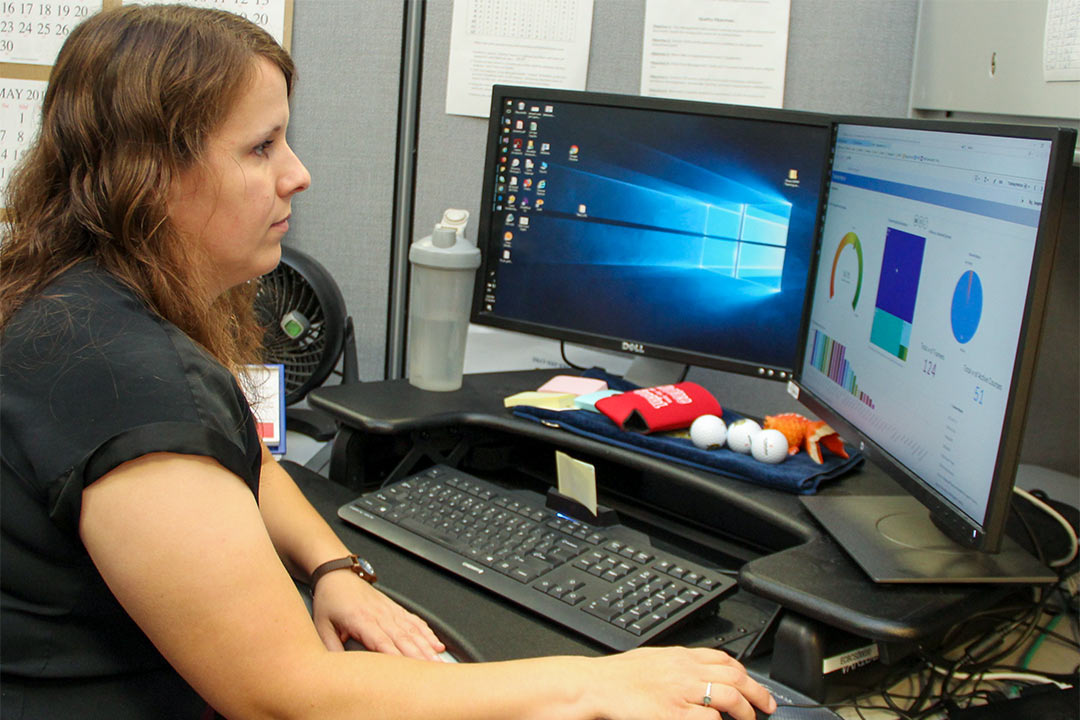// NEWS RELEASE
Chemical Biological Center Develops Software to Track Deadly Materials
CCDC Chemical Biological Center Public Affairs | December 5th, 2019
Chemical Biological Center Develops Software to Track Deadly Materials
DEVCOM CBC Public AffairsDecember 5th, 2019

Lauren Herkes of the CCDC Chemical Biological Center’s Knowledge and Data Management Branch at Rock Island Arsenal works with the BSAT Application Dashboard.
Department of Defense (DoD) research laboratories handle some of the most deadly agents and toxins in the world in order to research technologies to defend warfighters against them. Accounting for those materials as they move from the laboratory in which they are generated to other research laboratories around the nation and the world to their ultimate deactivation is vital. DoD stood up the Biological Select Agents and Toxins (BSAT) Biorisk Program Office (BBPO) in 2016 to ensure that BSAT materials tracking and accountability meet the highest standards possible.
That’s where the Combat Capabilities Development Command (CCDC) Chemical Biological Center comes in. Under Army Directive 2016-24, the Joint Program Executive Office for Chemical, Biological, Radiological and Nuclear Defense (JPEO-CBRND) holds direct responsibility for the information system that tracks and maintains BSAT materials. To accomplish this mission, JPEO-CBRND needed customized software that would be absolutely reliable for use by DoD laboratories that handle BSAT material. That’s when the phone rang at the Center’s Knowledge and Data Management Branch located at Rock Island Arsenal, Illinois.
Although there was an existing BSAT tracking software program developed by a contractor, it had numerous bugs and could not support new features necessary to expand and refine tracking. The BBPO and JPEO-CBRND wanted software that could evolve over time to keep up with new and emerging BSATs, new best practices based on lessons learned, and facility surety improvements. So the programmers at the Knowledge and Data Management Branch got to work.
“We wanted to design a system in which BSAT material could be sent from one principle investigator (PI) to another in a way that would fully transfer ownership of it, and we wanted to do it in a smooth way because they have enough to do as it is with their research,” said Lauren Herkes, a business analyst in the branch and one of the chief architects of the software system. “So we worked closely with the PIs at the Army Medical Research Institute of Infectious Diseases, which was to be one of the first DoD labs to go online with the new system. We let them put our beta version through its paces and learned straight from them what worked well and what parts of the system needed further development.”
In all, the effort took 14 months. During this time, the branch had to keep the old system going by applying the digital equivalent of band aids as needed. Then, when the launch of the new system approached, the team performed three dry runs. “We had to make sure that the transition would be flawless,” said Herkes. In order to minimize disruption, they performed the actual launch during Washington’s Birthday weekend in February 2018. It took the team around eight hours to make the transition, and when the researchers returned to work the next week, they had a working system that was considered a 90 percent solution.
The new system received good reviews from the PIs using it. “They told us the BSAT Application Dashboard is intuitive and allows lab members to easily search and find their samples using a wide variety of search criteria,” said Herkes.
The team spent the next few months perfecting and routinizing system maintenance. Now Herkes and the team perform a comprehensive test for bugs, known as a ‘smoke test,’ every week, and they regularly document full compliance with DoD’s requirements for the system to the BBPO, the formal owner of the system. In September 2018, they added a feature that confirms the time, place and efficacy of BSAT agent deactivation. Deactivation data is both automatically routed to personnel responsible for agent destruction, and auto-archived for reporting purposes.
The other DoD laboratories that handle BSATs and use this software are the CCDC Chemical Biological Center; the Naval Surface Warfare Center Dahlgren Division in Dahlgren, Va.; the Navy Medical Research Center in Bethesda, Md; and prior to their divesture from the DoD BSAT program, the Air Force Research Laboratory at Wright Patterson Air Force Base near Dayton Ohio.
Reflecting on the achievement, Herkes said, “One main reason why the BSAT Application transition was so successful is because our team at Rock Island has very talented software developers, and they are dedicated to supporting our BSAT Application users. The other success factor was the amount of time that the researchers at the labs spent with us to help us understand their business processes, which we were then able to convert to system processes. We are fortunate to have such a great group of users to work with and we are happy to continue supporting them.”
The U.S. Army Combat Capabilities Development Command (DEVCOM) leads in the discovery, development and delivery of technology-based capabilities to enable Soldiers to win our nation’s wars and come home safely. DEVCOM is a major subordinate command of the U.S. Army Futures Command. The DEVCOM Chemical Biological Center is the Army’s principal research and development center for chemical and biological defense technology, engineering and field operations. The DEVCOM Chemical Biological Center is headquartered at Aberdeen Proving Ground, Maryland.
